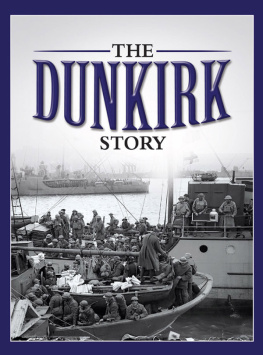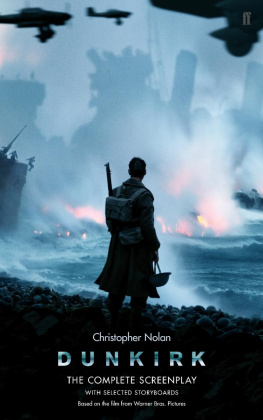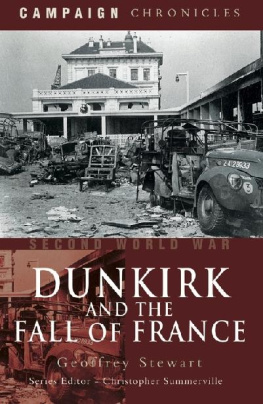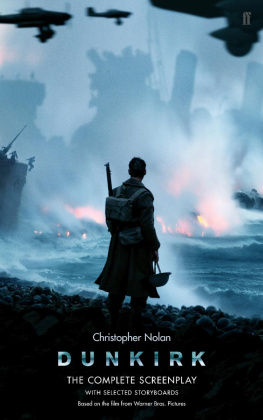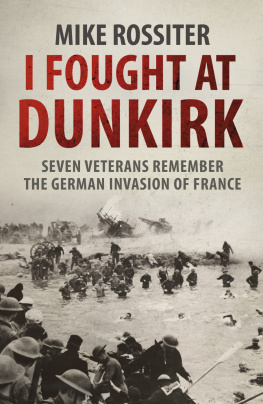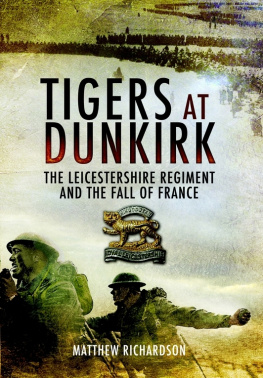Bruce Vigar - The Dunkirk Story
Here you can read online Bruce Vigar - The Dunkirk Story full text of the book (entire story) in english for free. Download pdf and epub, get meaning, cover and reviews about this ebook. publisher: G2 Rights Ltd, genre: History. Description of the work, (preface) as well as reviews are available. Best literature library LitArk.com created for fans of good reading and offers a wide selection of genres:
Romance novel
Science fiction
Adventure
Detective
Science
History
Home and family
Prose
Art
Politics
Computer
Non-fiction
Religion
Business
Children
Humor
Choose a favorite category and find really read worthwhile books. Enjoy immersion in the world of imagination, feel the emotions of the characters or learn something new for yourself, make an fascinating discovery.
- Book:The Dunkirk Story
- Author:
- Publisher:G2 Rights Ltd
- Genre:
- Rating:4 / 5
- Favourites:Add to favourites
- Your mark:
- 80
- 1
- 2
- 3
- 4
- 5
The Dunkirk Story: summary, description and annotation
We offer to read an annotation, description, summary or preface (depends on what the author of the book "The Dunkirk Story" wrote himself). If you haven't found the necessary information about the book — write in the comments, we will try to find it.
The Dunkirk Story — read online for free the complete book (whole text) full work
Below is the text of the book, divided by pages. System saving the place of the last page read, allows you to conveniently read the book "The Dunkirk Story" online for free, without having to search again every time where you left off. Put a bookmark, and you can go to the page where you finished reading at any time.
Font size:
Interval:
Bookmark:


We must be very careful not to assign to this deliverance the attributes of a victory. Wars are not won by evacuations
Prime Minister Winston Churchill, 4th June, 1940.
D unkirk today is a popular seaside resort between Calais and the Belgian border. For the crowds enjoying the seemingly endless sandy beaches there is little to remind us that this is where in June, 1940 the British Army came perilously close to being completely annihilated. Surrounded on three sides and with their backs to the sea they were plucked off the beaches by Royal Navy destroyers and a hastily assembled armada of small boats, some crewed by civilians.
There was little respite from the constant air attacks as men waded out shoulder deep to await their turn to be lifted into the boats.
The exhausted troops were brought back to England and disembarked at ports all around the south coast from Sheerness to Newhaven. From here, they quickly boarded trains and taken to reception centres for rest and an opportunity to re-form and reequip units. On their journeys they were greeted as heroes. Many had not eaten for days and so tightly scheduled stops of 15 minutes were arranged so that the troops could be given refreshments. But, the British public were not going to be denied their chance to show their appreciation of their men and many other stops happened along the way.

Bray Dunes Beach looking Eastwards

Bray Dunes Beach looking Eastwards
Code-named Operation Dynamo, the early hope has been to rescue between 20,000 and 30,000 troops. Admiralty figures record that between May 26th and June 4th, 338,226 men were rescued. It was a remarkable achievement indeed, the public regarded it a miracle but, most of their heavy equipment was left behind. With invasion threatening, Britains future was far from secure.

Dunkirk 1940
F ollowing Germanys conquest of Poland in September 1939, Hitler wanted to seize the initiative and attack western Europe thereby taking France and Great Britain out of the war. However, bad weather meant the planned offensive had to be postponed.
German plans were further compromised when a plane carrying the attack orders crashed in neutral Belgium in January 1940. Hitler was forced to rethink his plans.
Looking for advice, Hitler turned to General Erich von Mannstein. He recognised that the French defensive line called the Maginot Line that ran along the border between France and
Germany was too formidable an obstacle. Instead, he proposed a subsidiary attack through neutral Holland and Belgium. This would draw the British and French armies north. The main attack was then to be launched through the Ardennes with the aim of sweeping round the rear of the Allies.

General Erich von Mannstein
This was hilly and heavily forested country which the Allies had assumed would be impassable for an invading army. The German assault was to rely heavily on surprise Blitzkrieg (Lightning War) tactics.
Key to von Mannsteins vision was the use of substantial concentrations of Panzer divisions operating in a semi-independent role. By striking ahead of the main body of the army, they would disrupt and disorientate Allied formations.
It was a risky strategy as failure would jeopardise the whole offensive. Not surprisingly, von Mannstein had his opponents among the Armys senior commanders. But, Hitler, not without his own misgivings, gave the plan his approval.
Allied plans were, more or less, updated versions of those used in the First World War with one or two major differences. Having suffered monstrous numbers of casualties during the Great War, the French planned to adopt a defensive posture while mobilising her enormous army and industry to fight a total war. Only after about three years when the attackers were suitably ground down would she then go on the offensive.

Block 14 at Ouvrage Hochwald in 1940
A supposedly impregnable defensive line of forts and guns formed the Maginot Line along her border with Germany. It was confidently expected to protect Frances frontier with Germany, although crucially the line did not cover the Franco-Belgian frontier. In general, the slow-tempo, attritional fighting of World War One heavily influenced French military doctrine at the outbreak of World War Two.
Although the French had, on paper, a huge land army, it was a conscription army which meant that the quality varied. The conscription service had only just been increased to two years when war was declared and so many conscripts had barely a years training. Also, the conscripts were divided into Series A and B regiments. Series A was for men in their 20s and early 30s while Series B regiments were for men in their mid-30s and 40s. This latter group had few regular officers and were regarded as the most inferior in the French Army. As events unfolded the Series B units far outperformed their Series A counterparts probably due to the presence of men with fighting experience from the First World War in their ranks. Many of the French units which held the Dunkirk perimeter so selflessly and with great sacrifice were Series B or Regional Regiments.

Men of the 2nd Battalion, Coldstream Guards, part of the 1st Guards Brigade, arrive in Cherbourg, France, in the autumn of 1939

Bren carriers of the 13-18th Royal Hussars during an exercise near Vimy, 11 October 1939
But, the French army was a formidable force, one which prompted Winston Churchill to declare, Thank God for the French Army following Hitlers rise to power in 1933.
French strategy the Escaut Plan, or Plan E envisaged moving forces into Belgium once Germany had breached Belgian neutrality or they were invited to cross the border by the Belgians if invasion looked imminent. The extent of the forward move was dependent on events, which had been complicated in 1936 by the Belgian repudiation of the Franco-Belgian Accord of 1920. As a neutral, the Belgian state was reluctant to co-operate openly with France but did communicate information about Belgian defences. By May 1940, there had been an exchange of the general nature of French and Belgian defence plans but little co-ordination, especially against a possible German offensive westward through Luxembourg and the east of Belgium. Most of the French mobile forces were assembled along the Belgian border, ready to make a quick move forward and take up defensive positions before the Germans arrived. In October, 1939 the Belgians agreed to the Allied 1st Army Group taking up positions along the Escaut (Scheldt)
Font size:
Interval:
Bookmark:
Similar books «The Dunkirk Story»
Look at similar books to The Dunkirk Story. We have selected literature similar in name and meaning in the hope of providing readers with more options to find new, interesting, not yet read works.
Discussion, reviews of the book The Dunkirk Story and just readers' own opinions. Leave your comments, write what you think about the work, its meaning or the main characters. Specify what exactly you liked and what you didn't like, and why you think so.

